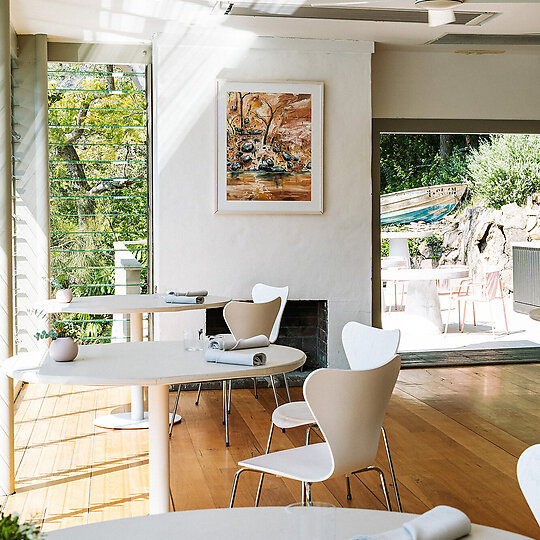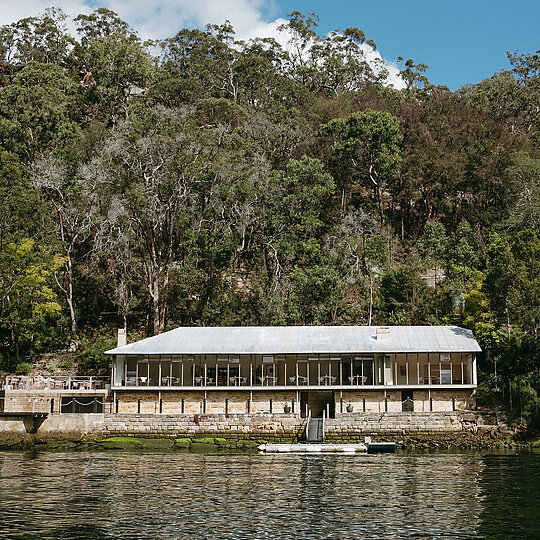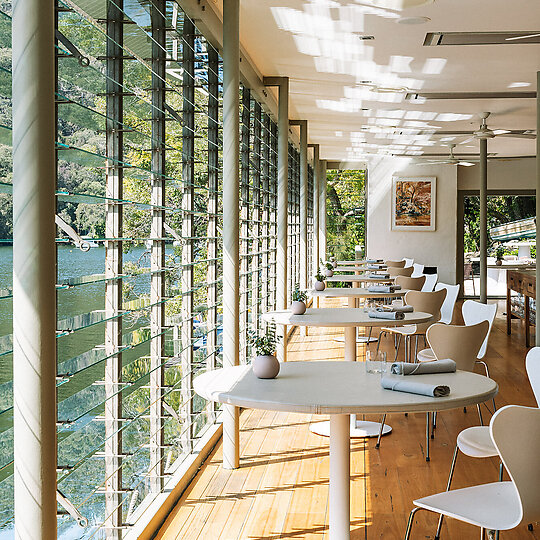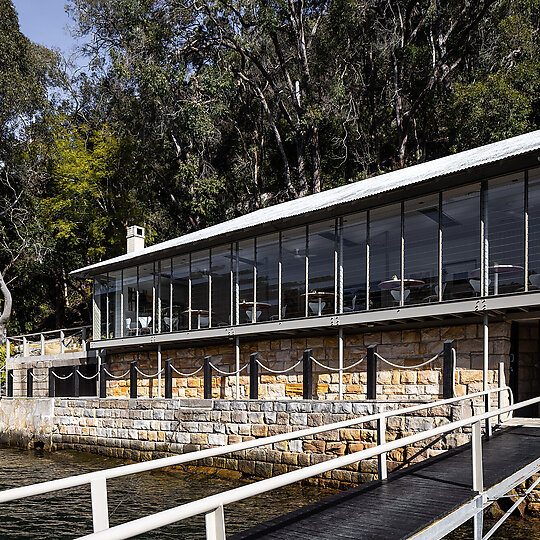2024 Gallery
Inductee: Hall of Fame
Glenn Murcutt for Berowra Waters Inn
1 Calabash Point
Berowra Waters, NSW
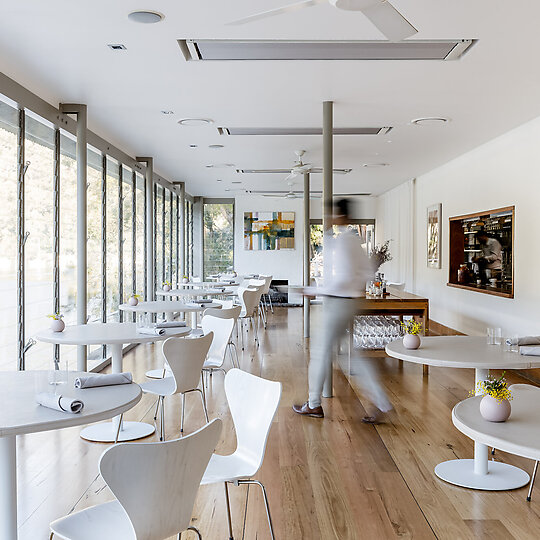
Reflection by Cassie Hansen
Nestled on the cliffside banks of the Berowra Creek, one hour north of Sydney, Berowra Waters Inn has attracted diners as much for its extraordinary setting as its culinary experience for more than 40 years.
The story of Berowra Waters Inn begins with a lunch in 1976. Tony and Gay Bilson had invited “up-and-coming architect” Glenn Murcutt to Berowra for lunch. The setting was the Bilson’s rundown riverside inn, a former tea house originally built in the 1920s and accessible only by boat. Glenn was familiar with Tony, having dined many times at his Sydney restaurant Bon Gout. Expecting half a dozen people to be at the lunch, Glenn was surprised to be greeted by just Tony and Gay. Over a long lunch, the Bilsons convinced Glenn to turn the dilapidated inn into a riverside venue. It would be Glenn’s first restaurant.
“I decided then and there that in principle it had the bones of a good space and it just needed a few strokes of doing the right thing,” says Glenn. “It was very much a riverside building, and I did not want to change that character.”
The simplicity of the building belies the complexity of its construction. Built in two stages (1977 to 1978, and then 1982 to 1983), the restaurant was designed in pieces, with every element – beams, steel supports and concrete – brought across on a “large tinny.”
“I remember times when that tinny was loaded to within around about 150 millimetres of the gunwale. If a big wash had come through, it would have gone to the bottom,” remembers Glenn.

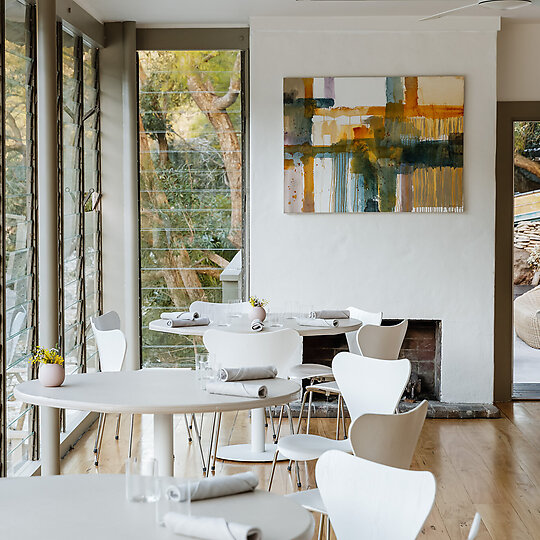
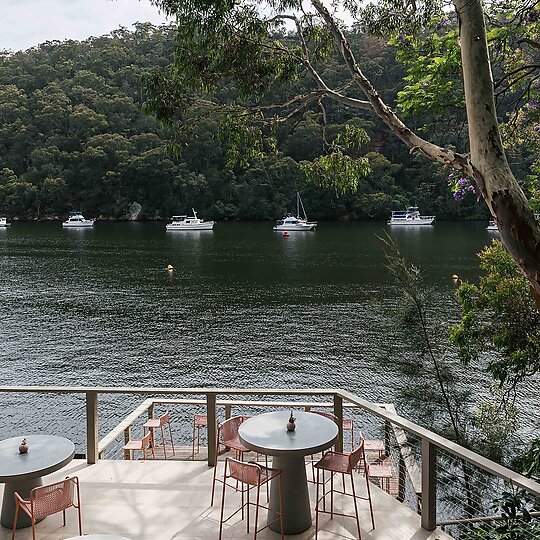
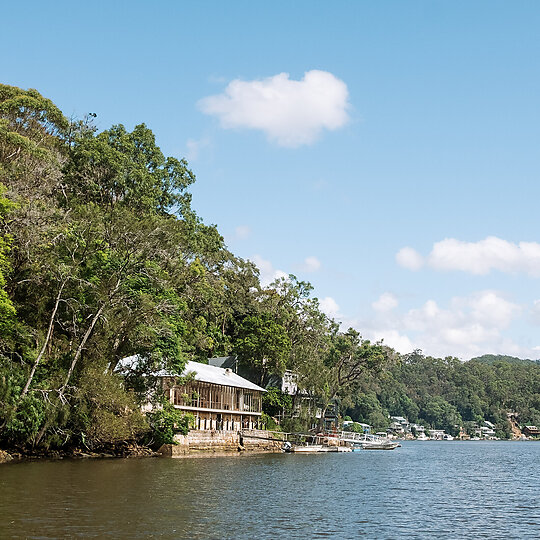
Today, guests can still only arrive via a punt or seaplane – there is no access by land. Restaurant staff await guests’ arrival and accompany them from the pontoon into the building, past the stone foundation and up a staircase. At the top of the staircase, they arrive at the dining room and the whole river view is finally revealed from the restaurant’s position on the hillside. “It’s a beautiful reception,” says Glenn.
At lunchtime, as the sun moves towards the west, the hillside lights up spectacularly. Seeing this, Glenn decided the building should be a “verandah by the water.” He retained the existing floor levels of the original building, and the ground-level wall was rebuilt using sandstone, recalling the rocks of the neighbouring cliffs. In the dining room, a continuous wall of louvres takes full advantage of the panorama and can be adjusted to “view the beautiful patterns on the water,” as Glenn says, and to suit the climate. Glenn recalls how, when he told friends in architecture about his plans for a wall of louvres, they told him he “had fallen off his perch.” But looking out to the view, seeing the sunlight coming off the cliffside and bouncing off the water and little boats flying up the Berowra waters, it is clear this is a window frame to Australia.
The dining room is long and narrow with a terrace on the eastern end. Every table is afforded a view. Tony and Gay bought the Arne Jacobsen chairs which are still used today. “The main room is such a simple and serene space. That was the aim of it,” says Glenn. He cites Luis Barragán’s assertion that “any work of architecture that is designed without serenity in mind is, in my view, a mistake, and when serenity possesses joy, it is ultimate.” The corrugated tin roof caps off the building and, suitably, its Australian vernacular.
In the second stage of works, a pavilion was constructed to house the bathrooms, dug into the hill behind the restaurant. A residential studio for Tony and Gay and their two daughters was also added to the restaurant’s western end.

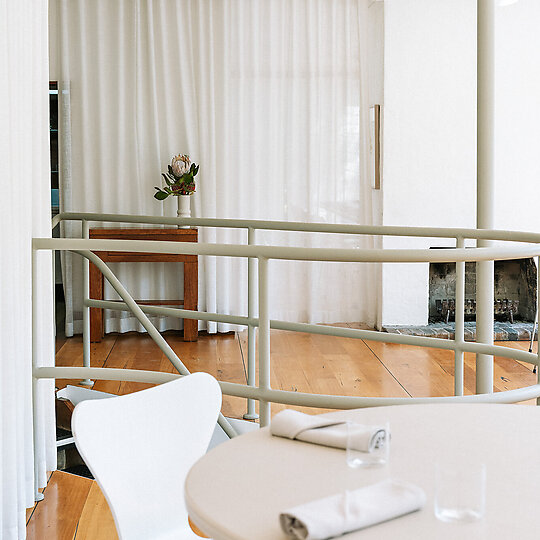
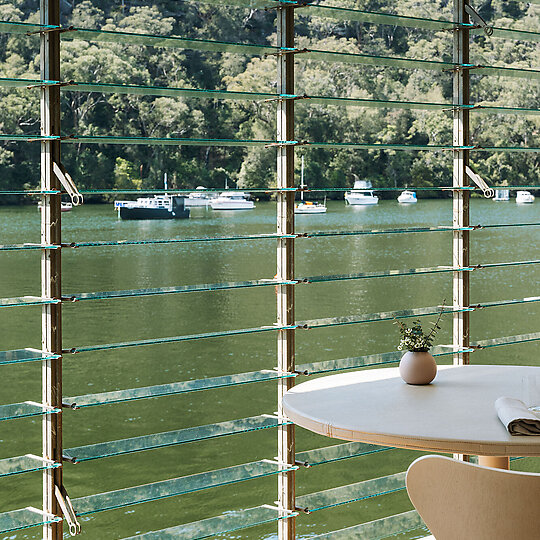
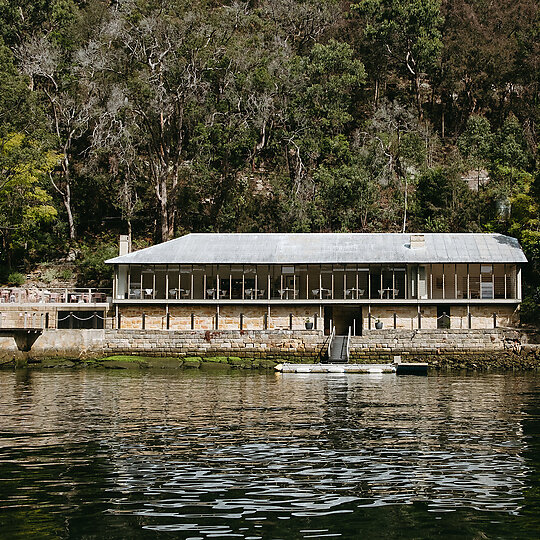
The current custodians of the building, Jeremy and Fiona Laws, purchased the property 25 years ago. “I felt a responsibility to maintain it the way it should be,” says Jeremy. “I wanted to preserve the intent of the building for future generations.”
Jeremy has seen numerous chefs and operators come and go at Berowra and the couple even operated it themselves for a time before ultimately handing over the reins to chef Brian Gehraghty. “The restaurant is now the best it's ever been,” says Jeremy.
“That building has changed everybody that’s had something to do with it. Brian has taken the philosophy of Glenn’s and, in the past, people tend to think, ‘What more can I put on the plate?’ But it’s not about that. We take away, which you learn from the building. There’s nothing there that shouldn’t be there,” says Jeremy.
Brian had worked for Tony at the three-hatted restaurant Bilson’s and had stints at Sydney’s Quay as well as London’s Pied à Terre. Joining the restaurant in 2012, Brian is the first to admit the significance of the architecture was initially lost on him.
“To be frank, at the very beginning, I didn’t really fully understand the gravity of the building. But as time went on, in the space of the first six months, I realised that every single review we received would mention the architecture. I was so focused on the food that it took me a while to realise that,” says Brian.
“Having worked at Bilson’s and in Europe, primarily France and London, everything about those types of restaurants was all about form and shape. And I really tried to bring form and shape to this restaurant and to the plate. It took me some time to realise that form and shape at Berowra is the building itself – and when it comes to the food, it has to be lacking structure.
“The building has to be the plate, per se, and the food is going to mirror the Australian bush.”
Brian says, “It’s about appreciating what doesn’t need to be there. I spoke to Glenn about this and when I said this, he said, ‘You’re just talking architecture now.’”
Brian, who moved into the building with his family during COVID-19 closures, has also spent a quarter of his life cooking there. When asked if the building needs to change to meet future needs, he says he thought about putting in brand new louvres to make the building more airtight. “But I’m in love with the 1970s latches too much.”
Of course, he’s not alone. Brian estimates that 50% of Christmas parties held at Berowra are architecture firms. “It’s ridiculous. Lots of weddings for architects, too. And we get architecture students who travel to Australia, rent a kayak, paddle up to the restaurant, take photos of the building, then paddle away.”
For Pritzker Prize-winning architect Glenn, Berowra Waters Inn is a treasured place, not only the first restaurant he designed, but the venue for his 40th and 60th birthdays and other family occasions over the past 40 years. “Fantastic things happened there,” says Glenn.
Berowra Waters Inn is undoubtedly one of Australia’s best restaurants. As one of the few Glenn Murcutt buildings that can be experienced by the public, it holds its role as a significant treasure, delighting fans of both architecture and food for more than four decades. It seems fitting to give the final word to Tony Bilson, taken from his memoir: “The sounds of the sea birds, the eagle’s high-pitched call, the kookaburra’s cackles and the currawong’s wolf whistles float across the water, their sound unsullied by the constant drum of cars. The guest should have a profound sense of place.”
Indeed, they do.
